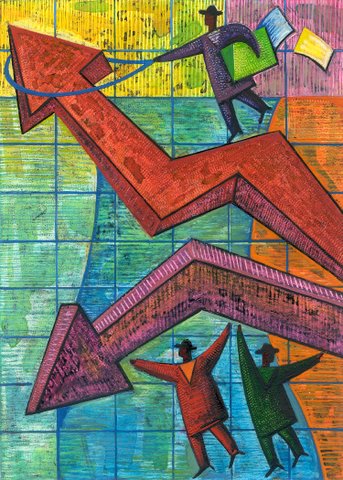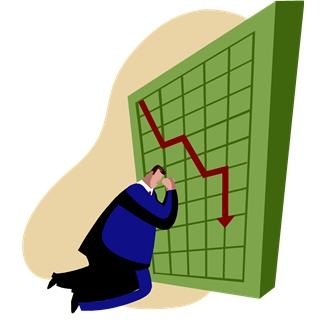| Home | About | Archives | RSS Feed |

@theMarket: Bottoming Out
 One could tend to dismiss this week's market move as just another short-covering rally triggered by unsubstantiated rumors from Europe. Friday's sell-off in the face of fairly good unemployment data bolsters that premise. So why do I feel we have further to go on the upside?
One could tend to dismiss this week's market move as just another short-covering rally triggered by unsubstantiated rumors from Europe. Friday's sell-off in the face of fairly good unemployment data bolsters that premise. So why do I feel we have further to go on the upside?Call it a feeling; call it a hunch, but the market's action over the last week or so makes me think that the rally is not quite over. I noticed that during our recent break of the 1,100 level of the S&P 500 Index (The Low) on Oct. 4, the number of new lows was less than the number of new lows in stock prices registered on Aug. 8. And on that same day, the number of stocks above their 200-day moving average reached a low of 7 percent. On Oct. 4, we registered the same 7 percent low (but no more), putting in a "double bottom." This is a bullish sign.
At the same time, the CBOE Volatility Index (VIX), the investor fear barometer, failed to break out to new highs, despite a lower low in the market. Finally, despite the string of bad news out of Europe, many of the European indexes did not make new lows. Now I know that all this is a bunch of mumbo jumbo to most of my readers. That's OK.
The takeaway is that the internals of this market are starting to show some positive divergences. At the very least, I would not be shorting this market quite yet if I were you. Certain European leaders are making noises that sound like some kind of definitive deal is in the works to resolve the financial crisis among its members.
Stateside, the economic data seems to be turning neutral as opposed to negative. Weekly retail sales were a positive surprise, the economy gained more jobs than expected and there is an outside chance that investors are too negative on the upcoming earnings season.
Now, a little more upside does not mean that the correction is over. We are in a bottoming process. That could take a few more weeks to resolve. I recently wrote a column ("Should you be worried about October?") in which I explained that "September is usually the month where crashes occur and October is the month that ends them."
Our recent low on the S&P 500 was 1,074.77. Could we break that low? Sure we could, but I would be a buyer if we did. Predicting the actual bottom of a correction is more luck than anything else. I would prefer to state a range. Right now let's say we surprise to the upside next week on some news out of Europe. The S&P experiences a sharp reflex rally to 1,225 or more before swooning once again. We fall back to the lows and maybe even break them.
I would be focusing on purchasing industrials, materials, technology, large cap and dividend stocks. I would also look at Germany as well as developed markets outside of North America such as Europe, Australasia and the Far East as represented by the MSCI EAFA Index.
Bill Schmick is an independent investor with Berkshire Money Management. (See "About" for more information.) None of the information presented in any of these articles is intended to be and should not be construed as an endorsement of BMM or a solicitation to become a client of BMM. The reader should not assume that any strategies, or specific investments discussed are employed, bought, sold or held by BMM. Direct your inquiries to Bill at (toll free) or e-mail him at wschmick@fairpoint.net . Visit www.afewdollarsmore.com for more of Bill's insights.
@theMarket: No Where Land
|
"He's a real nowhere man,
Sitting in his Nowhere Land, Making all his nowhere plans for nobody." |
If there was ever an argument for staying on the sidelines, this week's market action should have driven that point home to even the most aggressive investors. We are betwixt and between, groping blindly through a fog of confusion, rumors and false starts. Over the short-term expect more of the same.
Europe continues to be the dog that wags our tail over here in the U.S. A Wall Street Journal headline like "German Vote Bolsters Rescue" sends the markets higher one day only to crash the next when the next headline contradicts yesterday’s news.
"Why can't they make up their mind," grumbles a reader from Great Barrington. "This travesty has been going on for well over a year."
If it were just that simple; unfortunately, the European Union consists of many countries and even more voters who have different ideas about how and what the ultimate solution to Greek or Portugal or even Italy's debt should be. As a result, the process of building a consensus is excruciatingly slow with countless starts and stops.
 What the markets need to do is unhook from the day-to-day give and take among the European players. But what we need to do and what we actually do are sadly disconnected, which explains much of the present volatility in the markets. As for me, I am in the camp that Europe will solve their problems, maybe not today or tomorrow, but they will come up with a solution that over time will lead to economic stability.
What the markets need to do is unhook from the day-to-day give and take among the European players. But what we need to do and what we actually do are sadly disconnected, which explains much of the present volatility in the markets. As for me, I am in the camp that Europe will solve their problems, maybe not today or tomorrow, but they will come up with a solution that over time will lead to economic stability.It is clear that Germany has emerged as the strong man of Europe and as such investors should take a close look at the country as a potential area of investment. The country's stocks and exchange traded funds have been sold indiscriminately along with weaker countries such as Ireland, Portugal and Greece providing an opportunity for those who are willing to wait.
As readers may recall, I changed my tune on a possible return to recession after a spate of weak unemployment and GDP data over the last few months. The data has continued to indicate a weakening economy, but up until now, both the government and most economists maintain the U.S. is still growing.
The Economic Cycle Research Institute last week announced that they believe the U.S. economy is indeed tipping into a new recession. Why should you care what one economic forecasting outfit says? Well, their track record has been pretty good, calling the last three recessions accurately without any false alarms in between. According to ECRD, weakness is spreading from one indicator to another and there is not much anyone can do to avoid or turnaround what they believe will become an increasingly vicious cycle.
The oversold market rally I expected last week occurred on schedule. At its height it delivered over a 4 percent gain in just three days before disappearing just as quickly. Since then the daily volatility, if anything, has increased with averages moving up and down a percent or more in mere hours. Trading this market is a recipe for disaster. Even professional traders have backed off after losing substantial sums in intraday trading.
I continue to believe investors should remain in defensive sectors, dividend plays, cash and the bond market.
Bill Schmick is an independent investor with Berkshire Money Management. (See "About" for more information.) None of the information presented in any of these articles is intended to be and should not be construed as an endorsement of BMM or a solicitation to become a client of BMM. The reader should not assume that any strategies, or specific investments discussed are employed, bought, sold or held by BMM. Direct your inquiries to Bill at (toll free) or e-mail him at wschmick@fairpoint.net . Visit www.afewdollarsmore.com for more of Bill's insights.
@theMarket: Highway to the Danger Zone
|
"Highway to the Danger Zone
I'll take you Right into the Danger Zone" — Kenny Loggins from the movie "Top Gun"
|
One would think that the world is coming to an end. By Friday morning every headline, every opening sound bite on television and on the radio began with the massive declines experienced by world stock markets this week. Take all this with a grain of salt.
"You never bet on the end of the world," said Art Cashen, the experienced Wall Street veteran and director of floor services for UBS. "That only happens once and the odds of something happening once an eternity are pretty long."
 I respect Art and agree with his prognosis. Readers get a grip. This is a correction, a nasty decline for sure, and will, by the end, take away as much as half of the gains you have made since March, 2009. But remember, even if you are still one of those buy and hold, hold-out investors, you are still up 50 percent from the lows.
I respect Art and agree with his prognosis. Readers get a grip. This is a correction, a nasty decline for sure, and will, by the end, take away as much as half of the gains you have made since March, 2009. But remember, even if you are still one of those buy and hold, hold-out investors, you are still up 50 percent from the lows."But I'm still underwater from what I had in 2007," laments one reader from Connecticut.
For years I have been imploring readers to find a money manager or broker who does not believe in holding a portfolio through thick and thin. It is a recipe for disaster, in my opinion, that only works during certain specific time periods. The first 20 years of this, the 21st century, is not one of those periods. The problem is that only a small handful of investment advisers (less than 5 percent) within the financial services community actually buy and sell. But since it's your money, I would urge you to do the work and find one.
It may not be the end of the world, but at the same time I am not discounting the risks that face us. We are truly accelerating down the highway into an economic danger zone. The continuing weakness in our own economy, the very real possibility of a European bank failure and Greek default, a hard landing in China, plus another half-dozen potential mind fields does not give one a high degree of comfort. When one acknowledges that we lack the leadership, both here and abroad, to handle this dogfight, even Maverick and Goose might panic.
Instead, it is a time to stay calm and focused. Remember, I was here for you through 2008-2009 and if you followed my advice then you did very well. And I'm here for you now.
No one who reads this column consistently should be surprised with the market's recent declines. In last week's column, John Roque, my friend and one of the best technical analysts on Wall Street, clearly indicated that he thought that a decline to 950 on the S&P 500 Index was a strong possibility. I agree with him wholeheartedly. Yet, even at 950, I don't believe it is the end of the world as we know it.
It also does not mean that stocks must go straight down to that 950 level. I expect there will still be some ferocious rallies to the upside, like we experienced the week before last, where the indexes gained 6-7 percent in three days. I advised investors to sell those rallies. If you haven't already taken my advice and reduced your equity holdings, do so on the next bounce and move into cash or bonds.
Some retired investors need to remain in dividend-paying stocks because they are dependent on the income to make ends meet. If you are in that category, then please consider hedging those holdings with covered put options or inverse exchange traded funds.
On a short-term basis, the markets are oversold. I would not be surprised to see another bounce ahead of us but it does not change the overriding trend, which is down, act accordingly.
Bill Schmick is an independent investor with Berkshire Money Management. (See "About" for more information.) None of the information presented in any of these articles is intended to be and should not be construed as an endorsement of BMM or a solicitation to become a client of BMM. The reader should not assume that any strategies, or specific investments discussed are employed, bought, sold or held by BMM. Direct your inquiries to Bill at (toll free) or e-mail him at wschmick@fairpoint.net . Visit www.afewdollarsmore.com for more of Bill's insights.
@theMarket: Where Is the Bottom?
 Everyone seems to be looking for the same thing, an end to the pain, an end to the stress, a place where the selling stops. It's called a bottom and it appears to me that we haven't found one yet.
Everyone seems to be looking for the same thing, an end to the pain, an end to the stress, a place where the selling stops. It's called a bottom and it appears to me that we haven't found one yet.
One contrary indicator is the sheer number of bottom fishers who are trying to outguess each other on how low the markets can go. Normally bottoms are reached when no one wants to buy and everyone believes the markets are never, ever coming back. So far, I have seen no evidence that investors are in that state of mind.
This has been a waterfall decline and as such, one can look back through history and see how markets have reacted to past selloffs of this type. If you haven't read my Aug. 11 column, "What To Expect From After a Waterfall Decline" please be sure to read it.
Over the last two weeks, the market declined to about 1,100 on the S&P 500 Index and then proceeded to bounce 9.5 percent to about 1,204. Many think that was the bottom. But was it? I looked at some historical data on past waterfall declines, compliments of Ned Davis Research, a highly respected financial firm, hoping to confirm or deny that supposition.
I found that in 8 of 11 post-waterfall decline cases since 1929, the market has made lower lows. So far this decline has been a textbook waterfall decline. They all begin with a breath-taking whoosh downward, find an interim bottom, (in this case S&P 1,100) and proceed to bounce about 10 percent to an interim peak. Our rally this week to 1,204 was about 9.5 percent and would certainly seem to qualify as an interim peak.
Eventually this interim peak is followed by a decline to the final bottom, which in past declines have averaged about 14 percent to 16 percent. That would put the S&P 500 Index at around 1,020. But that is an average decline. If you look at waterfall declines that were caused by debt-related fears such as in 2008, 1940, 1937, 1938 and 1929, then, the bottoms were a good 10-15 percent lower than the average.
Now that does not mean that this decline must replicate past performances. And remember, too, that this type of bottom occurred in 73 percent of the cases since 1929. Therefore, 2011 could turn out differently. My intention is neither to frighten readers nor to call the bottom but rather to give you an idea of what has happened in the past and give you a framework for future risk/reward. At the very least, I would think that there is sufficient historical data to reframe from jumping into the market again at some arbitrary number whether it be 1,100, 1,075 or 1,020.
Bottoms are rarely V-shaped. There is usually a basing period of several months where the markets trade up and down, testing the lows until a sufficient amount of evidence convinces investors to get back in the market. The sectors that perform the best in a basing/testing period are health care, energy, consumer staples, telecom and utilities. Once the market bottom is in, then the sectors with higher betas such as technology, consumer discretionary, financials and industrials outperform.
Bill Schmick is an independent investor with Berkshire Money Management. (See "About" for more information.) None of the information presented in any of these articles is intended to be and should not be construed as an endorsement of BMM or a solicitation to become a client of BMM. The reader should not assume that any strategies, or specific investments discussed are employed, bought, sold or held by BMM. Direct your inquiries to Bill at (toll free) or e-mail him at wschmick@fairpoint.net . Visit www.afewdollarsmore.com for more of Bill's insights.
| Tags: decline, waterfall, bottom, history |
@theMarket: The Name of the Game — Dividends & Interest
 Last week, I advised investors to "wait for the bounce" before getting more defensive. We've had three bounces this week, so by now you are either out of your most aggressive investments or nearly so. Stay defensive.
Last week, I advised investors to "wait for the bounce" before getting more defensive. We've had three bounces this week, so by now you are either out of your most aggressive investments or nearly so. Stay defensive.
Never has the Dow Jones Industrial Average experienced the kind of swings we have witnessed this week. With 400-500 point swings a day, up and down, it is clear to me that high frequency trading owns the stock market right now. It is no place for the individual investor.
"Have we put in a low?" asks a client from Northern Berkshire County.
It seems so, but only time will tell. I know that is a iffy answer but here's why: The S&P 500 Index has bounced off 1,100 twice this week, giving technical analysts some hope that we have found a level where buyers are willing to step in. Since then, we have climbed almost 100 points or 6 percent in just two days. Normally, the next reaction will be a retest of the lows. That will determine whether 1,100 truly is the low. If it breaks — look out below. We could easily drop another 50-100 points.
Now you will probably agree that for most of us, that isn't a bet we are willing to make, especially if your portfolio is still fairly aggressive. That's why I am suggesting that you take a more defensive stance. Switch to large cap dividend socks, corporate bonds and, if you have the risk appetite, high-yield bonds as well. There are dozens of exchange-traded and mutual funds that offer plenty of choices; just watch out for high expense ratios and front load sales charges.
"Why not go to cash?"
That is a question I've heard repeatedly this week from clients throughout the Northeast.
In general, I wouldn't forsake the stock market quite yet. The jury is still out on whether we are heading for a recession. If we continue to wallow along in our slow growth, low interest rate, high unemployment economy, then the stock market is not going to decline much further. On the other hand, it won't be going up much either.
In that kind of environment, you want to find the highest dividend and interest income bearing investments around. Think of it this way: if the stock market provides sub-par returns for the next year or two (1-2-3 percent) than capturing interest and income returns of 3-6 percent will be a great way of beating the market and reducing your risk.
Fortunately, thanks to the market selloff, you can pick up great deals in that area right now. Those large cap companies that have a large part of their business overseas and pay large dividends are ideal candidates. But don't forget preferred stocks, they are a great way of both participating in any upside in the market while enjoying a healthy stream of income.
The risk of a spike in interest rates has receded. Now that the Federal Reserve Bank has assured investors this week that they will keep interest rates low until the middle of 2013. Investors have been given a window of opportunity to hunt for higher yielding alternatives to U.S. Treasury bonds. So over on the bond side, corporate bonds — both investment grade and high yield — make sense.
The wild card in this strategy is that the Obama administration or the Fed surprises us with another program to stimulate the economy. After all, there are some uncanny similarities between what is happening right now and what happened during this same time period last year. The stock market has declined by about the same amount. Investors were greatly concerned last August (as they are now) that the economy was slipping back into recession.
In late August of last year, Fed Chairman Ben Bernanke announced QE II at the Fed's annual meeting in Jackson Hole, Wyo. Bernanke will speak again on Aug. 26 at the same meeting. Some hope he will announce a second market-propping program to further stimulate the economy, something we now know the central bank is at least discussing. That belief stems from the following sentence buried in this week's FOMC statement
"The Committee discussed the range of policy tools available to promote a stronger economic recovery in a context of price stability."
That statement, although short, was significant, but was largely overlooked as the news of the Fed's decision to extend its low-interest-rates policy to 2013 took precedence among the nation's media. Now, just because the open market committee is discussing these things doesn't mean they are ready to act. Nonetheless, it is a possibility. Be forewarned that the volatility in the markets will continue as more participants move to the sidelines, leaving only high-frequency traders and their computers to battle it out minute by minute.
Bill Schmick is an independent investor with Berkshire Money Management. (See "About" for more information.) None of the information presented in any of these articles is intended to be and should not be construed as an endorsement of BMM or a solicitation to become a client of BMM. The reader should not assume that any strategies, or specific investments discussed are employed, bought, sold or held by BMM. Direct your inquiries to Bill at (toll free) or e-mail him at wschmick@fairpoint.net . Visit www.afewdollarsmore.com for more of Bill's insights.

